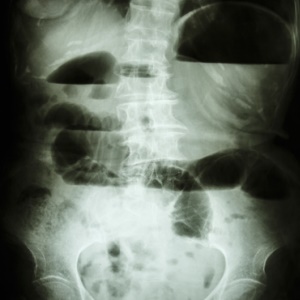
Mr A (45) presents to his GP with agonising abdominal pain. Read the full case here.
Importance of history and examination
In this case, keeping the patient's history in mind is crucial. Two years ago Mr A suffered a peptic ulcer that eroded through his stomach wall for which he needed surgery. Often after major abdominal surgery, bands of fibrous tissue (adhesions) form between organs and tissues. Adhesions are like scar tissue that form on the inside of the abdominal cavity. This connects organs and surfaces together in abnormal ways which can then cause obstruction if the bowel gets caught up in one of these adhesions.
In Mr A’s case, adhesions are mostly likely the root of the problem as they may have entangled a piece of his small bowel, thus preventing the passing of faecal matter. This will explain the “swelling” of the abdomen and the nausea and vomiting. The fact that he is not able to pass any stool or flatus is very important in the establishment of the diagnosis as this is a clear clue that obstruction is present.
It is also important to rule out any other causes of obstruction like cancerous growths pressing on the bowel or a hernia where bowel gets caught in the hernia, causing obstruction.
On examination, the scarring from his previous surgery is important to note. The generalised tenderness, the decrease bowel sounds and the impression that the abdomen is distended supports this diagnosis.
Mr A’s heart rate of 109 and his increased breathing rate can be attributed to pain, but a blood gas test to exclude acid-base disturbances, which is very possible with bowel obstruction and can explain the fast breathing, would be a good idea.
Interpreting the X-ray
Mr A’s X-ray is has the classic appearance of bowel obstruction. Multiple air-fluid levels (appear as circles with a horizontal line through them – bottom part white, top part black) are visible. Air shows up black on X-rays, while solids (including bone) and fluids show up white. On the X-ray one can also see dilated bowel loops (large round areas giving the impression of big bubbles).
Mr A’s X-ray supports the clinical diagnosis of bowel obstruction. The doctor will, in addition to imaging, also do blood tests to diagnose and correct any metabolic disturbances as a result of the obstruction. Remember that with obstruction, absorption of nutrients from food is affected.
The kidneys play a vital role in ensuring metabolic equilibrium in the body after the bowel absorbs nutrients into the bloodstream. With obstruction, the acid-base balance in the body is disturbed and the pH (the acidity of a substance) of the blood is affected.
Treating bowel obstruction
Treating bowel obstruction depends on the degree of obstruction. In partial obstruction (the patient will still have similar symptoms and signs, but less severe. Patient can also usually still pass flatus and small amounts of stool) doctors can often take a watch-and-see approach where they will give the patient enough fluids via a drip and place a nasogastric tube to decompress the abdomen and bowels.
In less severe obstruction this usually resolves the problem. This approach is called “conservative management”.
In complete obstructions (like the case of Mr A), or where there is clear signs that the inside lining of the abdominal cavity (the peritoneum) is irritated, the only solution is surgery. During the surgery, the doctor will find the source of the obstruction and relieve it. Surgery is also considered in the case where a partial obstruction is not relieved after a couple of days with conservative management.
NOTE: Health24's on-site GP Dr Owen Wiese reveals new cases on Thursdays. The answer is posted with the story on Mondays, or you can get it in our Daily Tip – sign up here.
Previously on What's Your Diagnosis?
What's your diagnosis? – Case 1: vomiting and weight loss
What's your diagnosis? – Case 2: eye pain
What's your diagnosis - Case 3: strange behaviour and a bullet in the back
What's your diagnosis - Case 4: seeing odd things
What's your diagnosis - Case 5: mysterious lungs
What's your diagnosis - Case 6: runner with seizures
What's your diagnosis - Case 7: swollen knee
What's your diagnosis - Case 8: bloody semen
What's your diagnosis - Case 9: confusing neurological signs
What's your diagnosis - Case 10:diabetic teenager with unusual signs and symptoms
What's your diagnosis - Case 11:bruising with no apparent cause
What's your diagnosis - Case 12: severe tummy pain
What's your diagnosis - Case 13: severe sore throat
Image: Bowel obstruction from Shutterstock




 Publications
Publications
 Partners
Partners










